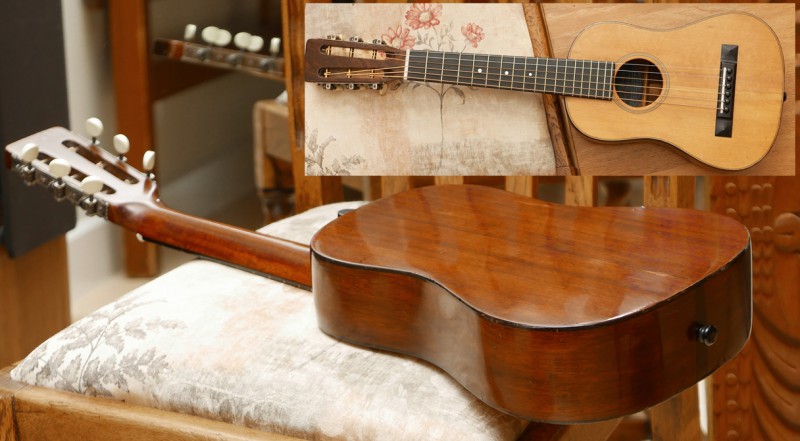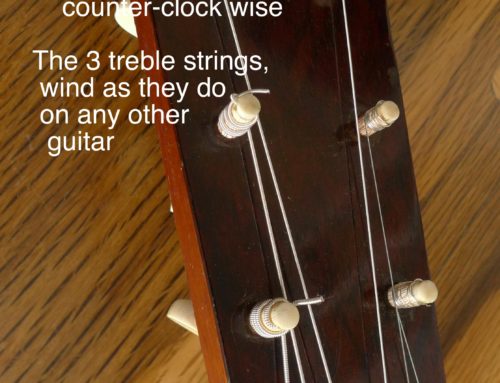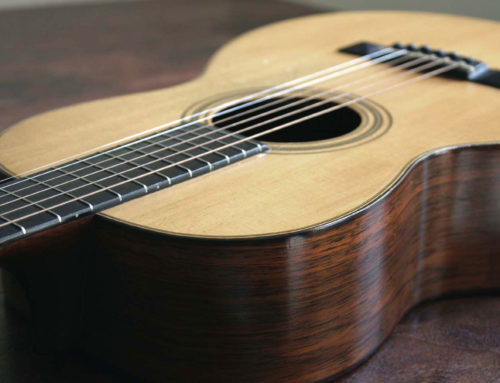A very rare, prewar Martin, and it’s the smallest pre-war Martin 6 string guitar ever made. It sounds amazing. Imagine if a fine prewar Gibson mandolin and a prewar Martin 6-string guitar had a baby– this is it.
Wonderful, how much sound this guitar puts out, and it has a shimmering tone that is mesmerizing. No I won’t say “as loud as any Martin”. It’s not, and that is not its charm. Its charm is in the way it produces a sound that is totally unique. And it loves to be played. By that I mean: don’t treat it delicately, but play it with vigor as you would a mandolin.
It’s a “1/4-18” Martin guitar, that was made in 1925, and marketed by SS Stewart.
You know what a D-18 is. And a 000-18. Adirondack spruce top, with mahogany back and sides. Well, this is a ¼-18, same thing, but smaller.
This size, the ¼-18, is in the Martin books/records. Very few people have even seen one, much less played one. Because there were less than forty made, ever (all pre-war).
There are only a small number of Martin guitars that were branded by SS Stewart, or Ditson. They are well documented.
This is one of them. SS Stewart label inside the Soundhole. Made by Martin. This guitar is in the Martin factory records, 1925, called a ¼-18 (i.e. a “quarter size”, style 18 guitar.) The country’s top Martin expert on the official Martin factory records, has confirmed it– this actual guitar. But it is obvious anyway.
According to Martin factory records, B&J (Buegeleisen & Jacobson, the big Martin wholesaler/distributor at that time) ordered this guitar on May 23rd, 1925. (B&J owned the SS Stewart brand at that time.)
About 39 of these guitars, were made by Martin, between circa 1918-1926. That is also in Martin books.
Specs and features of this guitar:
• Weight: 22oz, with strings
• Scale length: 17 inches
• Width at lower bout: 8 5/8 inches
• nut width: 1 10/16 inches
• width of bridge: 5 inches
• body depth: 2 3/4 inches at endpin
• overall length: 26 ½ inches
• it has the original Bar Frets (with a few frets near the soundhole replaced with T frets.
• fretboard inlays, binding, tuners, etc: all consistent with Martin specs.
• Two tapered-end braces on back; two tapered-end braces on top; thin maple bridge plate tapered
• The soundhole ring: the “single ring” is correct for Martin; specifically, according to the top Martin records expert, that single ring design, is precisely the “Customer Line” spec from Martin. (Customer Line, from Martin, also called C-Line for short: roughly 1922 -1925, these were Martins but just slightly modified in terms of a few specs, for shipping to a few customers like Ditson, B&J, etc.)
You can see that exact feature– the single ring soundhole, on this Martin-made SS Stewart instrument, in this link here:
http://www.vintagemartin.com/Martin23_Stewart217Spec.html
Also note: this “single line” soundhole, is also a feature of the Martin-built dreadnought made for Ditson.
We made a new replacement bridge here in Austin– all to exact perfect specs (someone had put a not really correct bridge on it in years past, some luthier probably twenty years ago– but luckily that bridge was not oversized, so it was a totally clean job to put a correct one back on). The finish is original. And there are no cracks on the instrument.
Easy to hold (it’s as light as a potato chip), but hard to put down. A unique bit of Martin history.





Leave A Comment